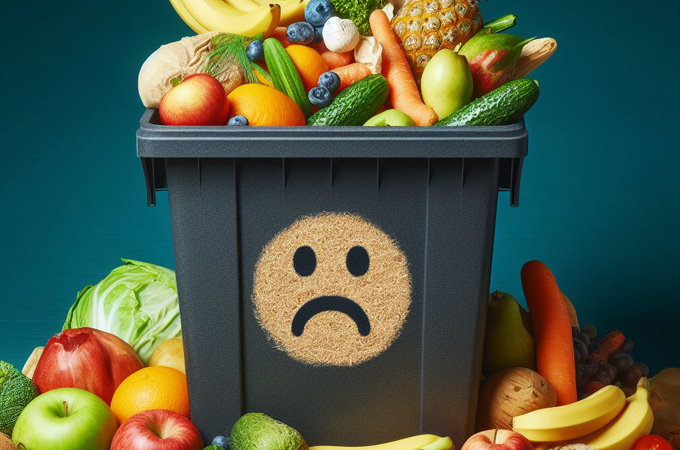
World wastes billions of meals daily, says report
NAIROBI, 29 days ago
Our world witnessed the squandering of an astonishing 1.05 billion tonnes of food -- that’s roughly one-fifth (19%) of all food available to consumers in 2022, says a new report.
This wastefulness extends beyond our kitchens and dining tables. The supply chain, from post-harvest to retail, leaks an additional 13%, as estimated by FAO.
These figures are highlighted in latest Food Waste Index Report that is tracking country-level progress to halve food waste by 2030 (SDG 12.3).
As we toss edible food into bins, 783 million people go hungry, and a third of humanity faces food insecurity.
Imagine a billion meals vanishing daily. That’s the reality: 79 kilograms of food per person annually, using a very conservative assessment on the share of food waste that is edible, says the report. This is the equivalent of 1.3 meals every day for everyone in the world impacted by hunger.
First published in 2021, the current report builds on recent and greater datasets and provides an update on the scale of food wasted worldwide, as well as a focus on multi-stakeholder collaboration through Public Private Partnerships (PPP) as a solution.
Most of the food waste originates in households, contributing a whopping 631 million tonnes to this colossal waste. The food service sector follows closely with 290 million tonnes, while retail adds 131 million tonnes to the tally.
But the ripple effect doesn’t stop there. Food waste isn’t just about discarded meals; it’s about global greenhouse gas emissions. A staggering 8-10% of these emissions stem from our wasteful habits -- almost five times the aviation sector’s total output.
Other key messages in the Food Waste Index Report 2024:
• Food waste is not just a ‘rich country’ problem. Following a near doubling of data coverage since the 2021 Food Waste Index Report was published, there has been increased convergence in the average per capita household food waste. High-income, upper-middle income, and lower-middle income
countries differ in observed average levels of household food waste by just 7 kg/capita/year.
• Temperature and Food Waste Correlation: Hotter countries appear to have more food waste per capita in households, potentially due to increased consumption of fresh foods with substantial inedible parts and lack of robust cold chain. Higher seasonal temperatures, extreme heat events, and droughts
make it more challenging to store, process, transport, and sell food safely, often leading to a significant volumes of food being wasted or lost.
• Urban-Rural Disparities: Middle-income countries display variations between urban and rural populations, with rural areas generally wasting less. Possible explanations include greater diversion of food scraps to pets, animal feed, and home composting in rural areas. The report recommends focusing efforts to strengthen food waste reduction and circularity in cities.
• G20 Role in Food Waste Reduction: Only four G20 countries (Australia, Japan, UK, and USA) and the European Union have food waste estimates suitable for tracking progress to 2030. An additional two G20 countries have suitable household estimates (Canada, Saudi Arabia), with Brazil’s estimate expected late 2024. G20 countries can take a leading role in international cooperation
and policy development to deliver SDG 12.3, can use their substantial influence on global consumer trends to promote awareness and education about food waste at home, and can share their expertise with countries just getting started in tackling this issue.
• Countries such as Japan and the UK show that change at scale is possible, with reductions of 18 per cent and 31 per cent respectively. Governments, cities, municipalities, and food businesses of all sizes should work collaboratively to reduce food waste and help householders to act.
• Public Private Partnerships to reduce food waste and impacts on climate and water stress are being embraced by a growing number of governments, regional and industry groups. Centred around a Target-Measure-Act approach, they bring stakeholders together to collaborate and deliver a shared goal, overcoming some of the challenges of a fragmented food system, and driving
innovation for long-term, holistic change.
• Countries should use the Food Waste Index to measure food waste consistently, develop robust national baselines, and track progress. Very few countries have collected robust food waste data, which is essential in understanding the scale of the problem, in targeting hotspots, and in
assessing the efficacy of interventions. Despite the wealth of household studies, only a few are suitable for tracking progress to SDG 12.3 at national level, and food waste data coverage in the retail and food service sectors remains poor.
• Seizing the opportunity of the next round of NDCs and NBSAPs: As of 2022, only 21 countries have included food loss and/or waste reduction in their national climate plans (NDCs), including Cabo Verde, China, Namibia, Sierra Leone, and the United Arab Emirates. The 2025 NDCs revision process
provides a key opportunity to raise climate ambition by integrating food loss and waste. Integrating comprehensive measures to tackle food waste within National Biodiversity Strategies and Action Plans (NBSAPs) is another opportunity for fostering sustainable development, actioning target 16 of the
Kunming-Montreal Global Biodiversity Framework, which specifically calls out halving global food waste by 2030.
Food waste must be addressed at both individual and systemic levels, including targeted efforts in urban areas and international collaboration among countries and across supply chains, the report urges. - TradeArabia News Service







